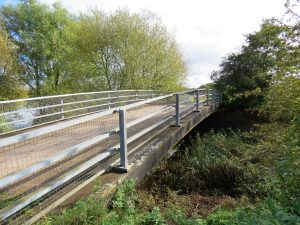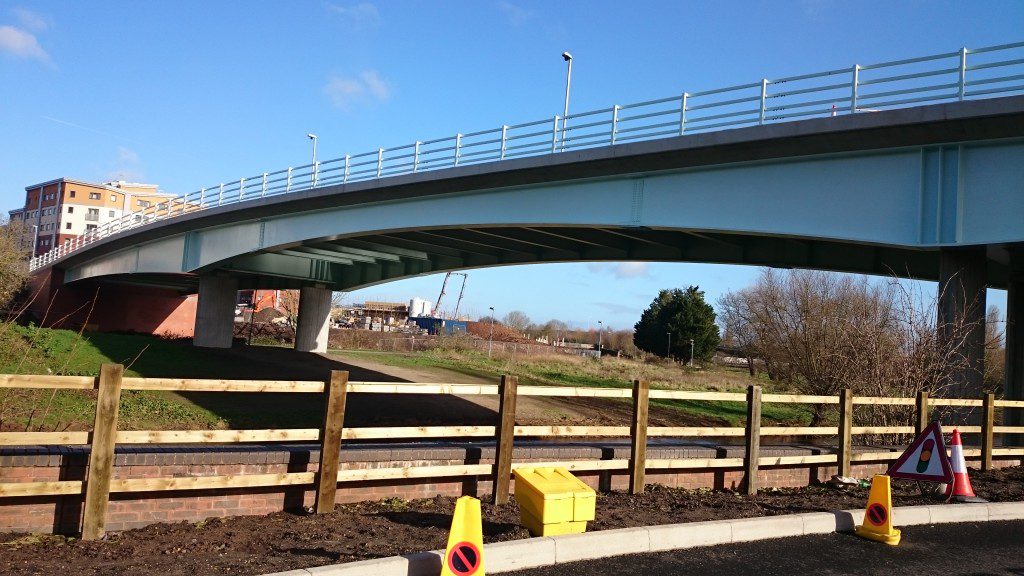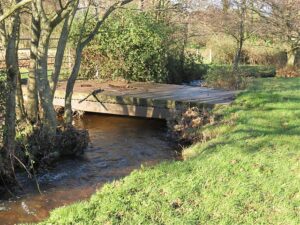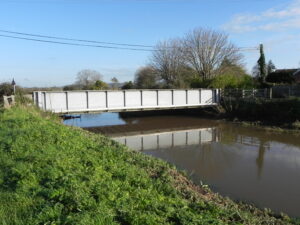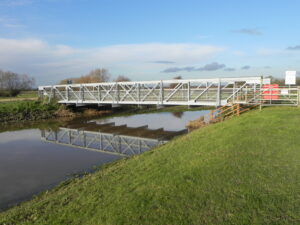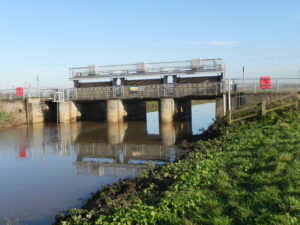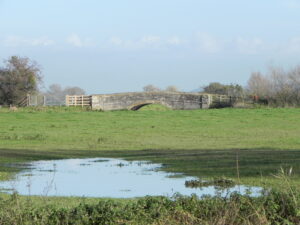| Existed in 1685. Extracts from the churchwardens accounts show that money was expended on it’s repair. In 1685 the sum was £1 6s 8d and in 1687 a rate was made towards the building of the bridge. In 1688 a sum of £6 was paid to Mr.Collins towards the bridge and in 1690 £1 2s 0d was spent on 4 elms and 3 oaks and a further £1 7s 0d for raising the bridge ends with earth, and other expences for labour, etc., about the Bridge. In 1711 Thomas Walter was paid £1 18s 0d for repairs and a sum of £1 0s 0d was spent in respect of an order at the Quarter Sessions for rebuilding the bridge.
In 1740 several payments are made to a Mr Weech in respect of law about Stanmoor Bridge, these total £29.It would appear that the bridge was rebuilt in 1754 for a sum of £104(From an entry in 1809 9 -see below)
At a vestry meeting In 1780 It being now reported to this meeting that Stanmoor Bridge a public Bridge lying in this Parish is now out of repair, and the same ought to be repaired by the Inhabitants of ten Parishes following, and by the proportions set against each of them, and that the sum of eight pounds is now necessary to be raised for the repair of the said Bridge. Resolved and ordered that Mr.Bendt Barrington and Mr. Laurence Tuttiett the younger, Church Ws. of Gregory Stoke do forthwith prepare a rate on the ten Parishes according to the proportions under named, and collect the same and apply, etc. The parishes were Aller Parish, Huish, Curry rival, Drayton, West Hatch, High Ham, St Mary Magdalene Taunton, St. James Taunton, North Curry and Gregory St.Stoke
1809, An assessment made for raising the sum of £8 from the ten Parishes for the repair of Stanmoor Bridge being the same proportion as were agreed or given in and settled between the Parishes at the general quarter sessions held at the Castle of Taunton on Tuesday 5”’ October 1754 when the Bridge had just before been taken down and rebuilt by the said Parishes at the expense of £104.
1814 A meeting concerning the affairs of Stanmoor Bridge, and whereas it appears by an ancient record in His Majesty’s Court of King’s Bench at Westminster that the Inhabitants of the several Parishes of (the 10 Parishes before named) have from time immemorial whereof the memory of man is not to the contrary being used and of right ought to repair the said Bridge, and whereas the said Bridge is now rebuilding and all the said parishes except Taunton have either paid or agreed to pay their respective proportions. We agree to employ Mr. H. W. Meade of N. Curry to prepare a case for the opinion of counsel and to advise as to necessary proceedings to compel payment.
1816 A vestry meeting. Concerning the new rebuilding of Stanmoor Bridge. It being reported the Bridge being under Indictment and being so much out of repair was obliged to be taken down and rebuilt. And by the ten Parishes before named it was necessary that £600 should be raised. It was resolved and ordered that Mr. Thomas Hurman Jnr and William House Ch Ws do forthwith make a rate on the Parishes and carry out the work.
1817, A vestry meeting. Concerning payment being made for the above rebuilding. Whereas different parishes have refused to pay their proport’ part. It was before agreed to employ Mr. H W. Meade to enforce payment from the Parishes of Taunton and he having neglected the same it was agreed to employ some other Solecetor
1820 A meeting concerning the raising monies for paying the purchase of the lives for the Church House and ground being £104. We agree to sell the several piece or parcel of ground belonging to the said Church House by Public Auction for the said purchase and also to pay Mr. Sam Hillard the remainder of his bill towards the new rebuilding of Stanmoor Bridge being £113
In 1901 Hugh P. Olivey wrote in his book “NORTH CURRY:ANCIENT MANOR AND HUNDRED” This substantial stone bridge remained until a few years ago when it was taken down by the commissioners of sewers. The road was then diverted and the river widened, the bank now occupying the position of the old road. The bridge was replaced by an inferior wooden structure.
The actual date of the replacement was 1884 when the Drainage Commissioners undertook to maintain the newly built bridge.
Jervoise states in 1930 that the bridge was a girder structure and that it was probably previously a timber bridge. He goes on to say ” At the Quarter Sessions, held in Wells in 1624, it was reported that Stanmore Bridge is greatly decayed and dangerous. The parishes concerned were ordered to repair or remake the bridge. In 1648 the bridge was again very much in decay, and rates were ordered to be paid for its repair. Four years later Ralph Frauncis, a carpenter, claimed payment for a repair to a ” certen woodden bridge called Stanmore Bridge”2
Whereas it appeareth by presentment that Stanmore Bridge is greatly decayed and dangerous for travellers, and whereas it likewise appeareth by an ancient order under the hands of Sir Nicholas Halswell and Robert CufTe, esq., and others, Commissioners of Sewers, that the said bridge ought to be repaired at the costs of the inhabitants of Aller, High Ham, Heywsh, Drayton, [ Curryrivell, Gregorystoake, North Curry, Taunton, Langport, and West Hatch : Ordered that the inhabitants of the said parishes shall repair or make new the said bridge before the 3rd may” and shall by that date collect pay such sums of money as be proportionately rated imposed upon=”upon” or at the next sessions show sufficient cause to (3)
It is known that Stanmoor bridge already existed in 1685. It would appear that the bridge was rebuilt in 1754 for a sum of £104. At a vestry meeting In 1780: “It being now reported to this meeting that Stanmoor Bridge a public Bridge lying in this Parish is now out of repair, and the same ought to be repaired by the Inhabitants of ten Parishes following, and by the proportions set against each of them, and that the sum of eight pounds is now necessary to be raised for the repair of the said Bridge. Resolved and ordered that Mr.Bendedict Barrington and Mr. Laurence Tuttiett the younger, Church Wardens of Gregory Stoke, do forthwith prepare a rate on the ten Parishes according to the proportions under named, and collect the same and apply.” (4) |

